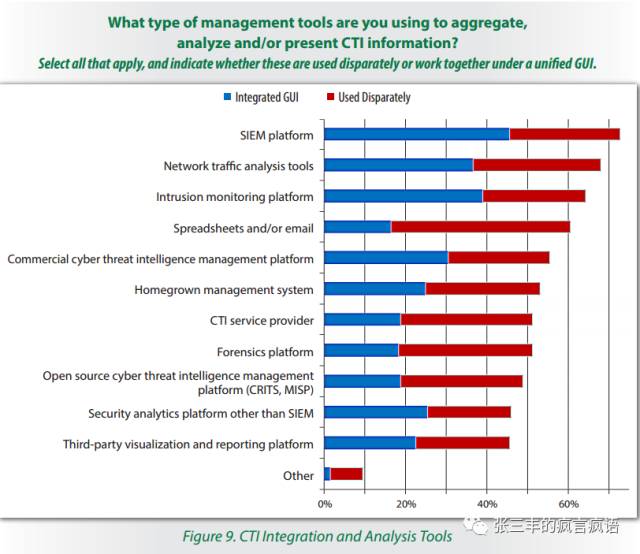SANS:2018年網絡威脅情報現狀調研報告

報告給出了SANS對CTI的定義:收集、整理和探尋關於對手方的知識。collection, classification, and exploitation of knowledge about adversaries。以及“analyzed information about the intent, opportunity and capability of cyber threats”(針對網絡威脅意圖、機會和能力的分析信息)。這個定義比較寬泛。
報告顯示,不少結果與去年的分析基本一致。譬如CTI的主要使用場景還是安全運營、應急響應和安全意識提升。SIEM依然是集成威脅情報的最佳選擇
SANS認為調研顯示北美地區對威脅情報的收集、集成和使用已經趨於成熟。下面就進一步看看接近成熟的威脅情報市場是個什麽樣子吧。
需要特別指出的是,SANS調研中對CTI的理解跟Gartner以及我的理解是不同的,SANS對CTI的界定更加廣泛,不僅包括嚴格意義上的威脅情報,還包括了漏洞情報,並且將特征庫(譬如惡意代碼簽名)也算在內。事實上,在全世界範圍內的威脅情報的具體實踐中,上述問題一直就比較模糊。尤其是對特征庫的認定,往往看作是最基本/簡單的威脅情報,而我們看到的大部分威脅情報信息其實就是signature!嚴格來說,我比較贊同Gatner的Anton Chuvakin的觀點,即威脅情報不是簽名!本人認為,由於這種寬泛的界定,降低了SANS這份威脅情報報告對於威脅情報利用情況的分析敏感度,從而失去了不少價值。
1)威脅情報的普及程度:調查顯示,沒有使用威脅情報,也沒有計劃使用威脅情報的受訪者比例只有11%,比去年的15%進一步降低。
2)更加註重內部威脅情報:盡管外部情報仍然是用戶主要的威脅情報來源,但對內部情報的重視程度顯著上升。所謂內部情報就是指借助自身的安全基礎設施和分析能力獲得情報,這類情報與用戶自身的相關度更高,有效性更強,是威脅情報下一步發力的重點。
3)威脅情報更多用於安全運營,包括:威脅檢測、威脅阻斷、威脅捕獵、威脅管理,等等。

4)人員配備上,41.5%的受訪者有專門的威脅情報團隊,12%表示至少有一個專人,31%表示有兼職人員,而沒有人負責威脅情報的情況只有16%。
5)威脅情報跟SOC團隊的相關性最高,也表明SOC最需要威脅情報,或者說威脅情報最適合跟SOC集成。

6)什麽類型威脅情報最有用?包括:攻擊中用到的惡意代碼指示器(其實還是惡意代碼簽名)81%,攻擊者利用的漏洞(其實就是漏洞信息)79%,攻擊者趨勢76%,IoC(占67%)。這個分析結果令我有些無語,畢竟排名前兩位的都是古老的東西。而針對未來哪些類型的情報最有用的調查中,我倒是發現人們更傾向於對威脅情報核心的信息的追求。譬如關註敵對方的信息,關註攻擊者的TTP,IoC,等等。

7)一些用戶使用CTI的感言值得一讀:
“We will monitor threat feeds and escalate [a] certain vulnerability remediation priority based on active exploitation campaigns in the wild. These feeds include vendor threat feeds or just security news.”
“We utilize several intelligence feeds to augment our perimeter firewall capabilities.”
“Pulled info on threat actors, source IPs, domains and [fed] them into EDR [endpoint detection and response] for [blacklists] and traffic reports from them.”
“We have alerting set up in our SIEM that correlates event searches against our subscribed threat intelligence feeds. From there we conduct our investigations and take whatever actions [are] deemed an appropriate response. The response is typically blocking malicious activities and hunting for further indicators of compromise across the enterprise environment.”
“As CTI raw data, we gathered ransomware IPs, domain names, file hashes from CTI providers as a service and integrated those valuable data [points into] our SIEM, malware analysis appliance, firewall and IPS. Then, when traffic occurs from our [network] to those
blacklisted IPs or when an email is received with a file attached with a hash of Wcry files, alarms are sent to related security teams. If the system is in blocking mode, we block that traffic.”
8)CTI都跟誰集成?如前所述,還是跟SIEM集成為最多選擇。

對比一下去年的,基本一致。

可以看出,更多的人選擇了SIEM。而選擇TIP的人依然排在第五位。
9)對威脅情報的整體滿意度。今年的數字是81%,去年是78%,前年是64%。而在具體對哪些地方滿意的調查中,主要體現在以下幾個方面(排名靠前的跟去年也差不多):

10)CTI依然面臨的主要挑戰。主要還是人員素質和水平、預算。
最後,引用一段SANS分析師的原話作為結束:
According to John Pescatore, SANS’director of emerging technologies, increasing automation and adding more staff are not the approaches organizations should take. He says, “The real successes in cyber security have been where skills are continually upgraded, staff growth is moderate and next-generation cyber security tools are used to act as ‘force multipliers’ that enable limited staff to keep up with the speed of both threats and business demands.”
【參考】
SANS:2017年網絡威脅情報現狀調研報告
SANS:2016年網絡威脅情報現狀調研報告
SANS:2018年網絡威脅情報現狀調研報告
